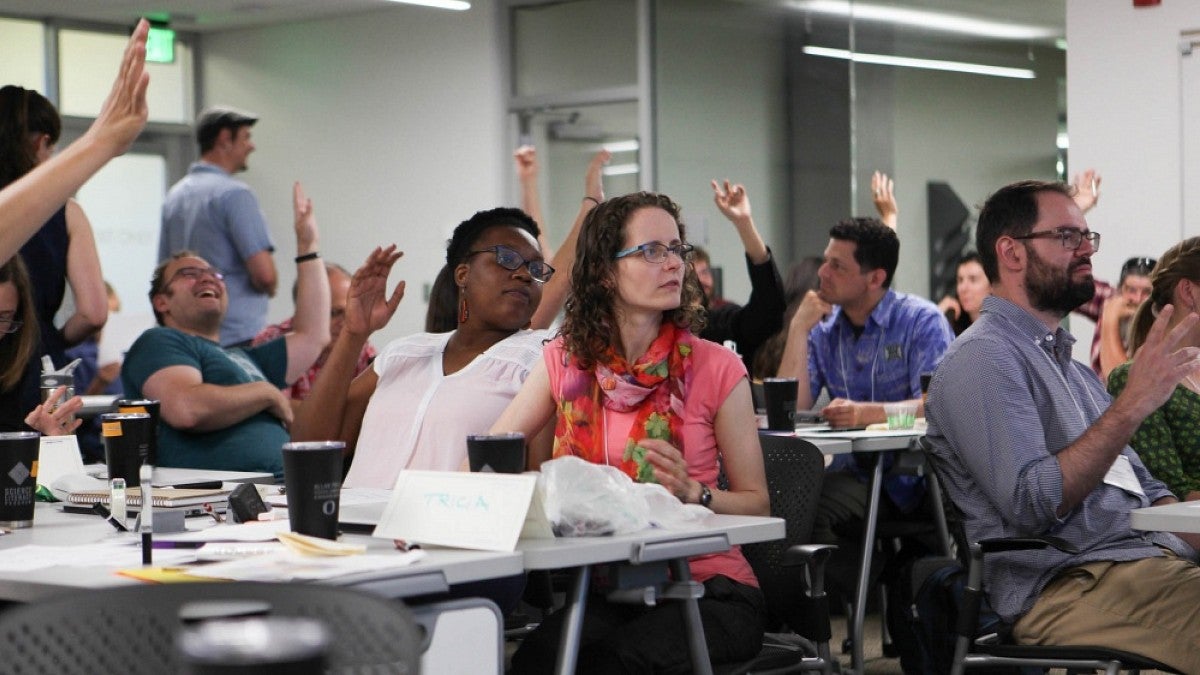Even teachers need to go back to school, especially when it comes to learning how to teach science better.
That’s an idea the University of Oregon has embraced with such gusto it has become a leader in efforts to make science classes more effective and engaging. And interest is spreading, from veteran professors to young doctoral students and post-doctoral fellows.
Andy Karduna has been teaching human physiology for more than two decades. Computational biologist Nyasha Chambwe has served as a teaching assistant and co-taught a semester-long seminar course. The two, at opposite ends of their academic careers, shared the same goal as classmates at the UO’s recent Summer Institute on Scientific Teaching: to learn how to teach science.
Funded by the Howard Hughes Medical Institute and directed by UO Science Literacy Program director Elly Vandegrift, the institute brought 55 faculty and postdoctoral researchers from across the country, including 23 from the UO, to campus for a week of evidence-based science teaching workshops.
“We are trained to be experts in our disciplinary fields, but that does not mean we have practiced how to communicate the science to nonexperts or have learned about approaches that support learning for all students,” Vandegrift said.
Karduna has tenure and serves as director of graduate studies for the UO’s Department of Human Physiology. Come this fall, he will develop a new a science class for students who aren’t majoring in science.
“I’m at a point in my career where I wanted a challenge, but I was never trained to teach,” Karduna said.
One of the approaches is called active learning. That’s where students are being engaged, participating and being assessed throughout an entire class rather than sitting passively through a lecture.
“There’s lots of evidence that students in lecture-based classes are much more likely to fail than students who are in active learning classrooms, and the impacts are much worse for students from minority, low-socioeconomic and first-generation college groups,” Vandegrift said.
Chambwe, a postdoctoral fellow at the Institute for Systems Biology in Seattle, is preparing to apply for faculty positions. She knows, wherever she lands, she will be teaching. Like most faculty, she was not trained to be a teacher or communicate to nonexperts.
“When I was a student, active learning wasn’t prominent, so I’m trying to learn those skills,” Chambwe said.
Attendees spent the week in discipline-specific groups (biologists with biologists, chemists with chemists). They created 25-minute courses based on active learning rather than lectures. The groups presented the courses to their peers at the end of the week.
Training in scientific teaching includes backward design and inclusive teaching practices as well as approaching science teaching in the same way scientists approach research. Backward design is when teachers develop the curriculum based on the course goals and what they want the students to learn. Assessments and class activities are all determined by the goals.
Summer institute participant Matt Barber, an assistant professor of biology at the UO, already is putting the lesson into practice as he prepares to teach his first college course.
“I’m learning techniques before I create the class so I don’t have to reinvent the wheel,” Barber said.
So is Karduna, who said he feels prepared now that he’s equipped with “a tangible skill set that I can use to develop a new class and make my current classes better based on evidence-based teaching.”
The summer institute is just one of several ways the UO is helping improve science teaching for college students. The Science Literacy Program provides general education courses for nonscience majors, hosts weekly journal club for science faculty and, as an affiliate of the Alan Alda Center for Communicating Science, offers workshops for scientists to improve their science communication skills.
—By Molly Blancett, University Communications


